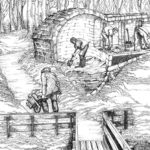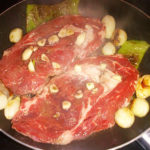 SMOKING
SMOKING
Meat was smoked in the same way as drying, fish or cheese – it was enough to hang well-salted portions within the range of smoke for some time, order after a few (for cheese or fish) or several hours (in the case of meat) these products took on better taste qualities and were preserved.
Probably the dependence of the appearance and taste of meat and the possibility of its longer storage on contact with the smoke rising above the hearth have already been noticed by hunters in the Stone Age. The temperature of the smoke reduces the moisture content of the meat and makes it fluff at the same time, and the substances contained in the smoke protect the meat against the development of putrefactive processes and the rancidity of the fat. Phenols resulting from burning wood give the smoked meat its characteristic flavor, similarly to meat proteins which react with carboxylic acids in the smoke. This is where you should pay attention, that deciduous wood must be used for smoking (we prefer the wood of fruit trees: apple trees, cherries, plum trees). Coniferous wood, because of the resin it contains, it may cause the browning of smoked products and a bitter taste. Nevertheless, at the end of smoking the meat, it is advisable to put a few twigs of juniper or other pine needles on the fire – it definitely increases the aroma of the smoked meat.
Although the knowledge of the chemical processes taking place during smoking was alien to the Slavs, they knew the effect very well, what resulted from suspending meat or cheese for a few days over the hearth that was burning in a chicken hut. The smoking process took place automatically in the smoke accumulating under the roof, without the need for additional treatments or devices. However, we know such devices from archaeological research – these are smoking cavities hollowed out in the ground. They were found in Sandomierz, Piotrawina, and above all in Biskupin, where almost the entire production center operating in the 9th and 10th centuries was discovered. Interestingly, only fish were smoked in these pits! Taking into account the Biskupin discovery, you can suppose, that smoking in the cavities was intended to increase the efficiency of the process and achieve even mass production. But it is possible, that another aspect also played a role. It's easy to imagine, that the smell of smoked fish was not necessarily as pleasant as that of smoked meat, and perhaps for this reason the fish were smoked in pits, and not under thatched roofs.
Smoking in the ground cavity is not too complicated, although it requires care and attention. Our experience shows, that the fire must be kept burning for so long in the first place, until a large amount of heat builds up, then place the stalked fish above it, cover the heat with sawdust from hardwood, and then cover everything with boards or even a jute sheet. You have to pay attention, so that the sawdust does not catch fire, because the fish can burn themselves.
In passing, let's mention, that during our Experimental Archeology Workshop we also tried to smoke meat or cheese wrapped in linen, suspended in the outlet of a pottery kiln. However, despite the care to kindle as little fire as possible in the oven, it was quite difficult not to exceed the fleeting line between smoking and baking.
Smoking jams have a long tradition in the Slavic region, and mainly fish and fruit were smoked in them. The remains of the pits from the 12th to the 14th centuries, in which, among others, sturgeons were smoked, discovered near Zmijowiska in Piotrawin on the Vistula. The process of smoking fish in cavities should be considered the beginning of Polish experimental archeology. W 1951 Professor Zbigniew Rajewski conducted an experiment in Biskupin that positively verified the possibility of such use of the numerous earth cavities discovered there, dated to the 9th and 10th centuries. Sometimes (also successfully) We repeat this tasty experiment in Zmijowiska.





